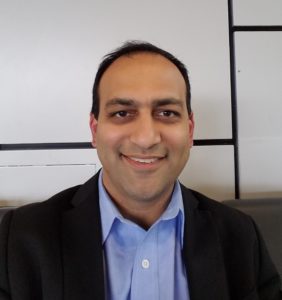Latest News
As Samsung’s vice president of networks strategy, Alok Shah has had a pivotal role in determining the company’s approach to the 5G rollout. Shah will be participating in the “Evolution of Applications, Ecosystem, Vertical Markets and Big Data Analysis in the 5G World” panel at the DC5G 2017 Summit on Oct. 11. In this interview with Via Satellite, Shah shares his perspective on the biggest opportunities Samsung is pursuing around the new technology.
VIA SATELLITE: What are the specific features of 5G that will enable new applications or improve old ones?
Shah: The 5G specification is set to enable three primary benefits over earlier mobile standards. The first is substantially higher data throughput, with gigabit per second rates in good coverage and more importantly 100 Mbps at the cell edge. Second, 5G will offer both low latency of about one millisecond and high link reliability. This combination enables new use cases for public safety and industrial applications. And finally, 5G supports a higher density of devices and the ability to create network slices with varying performance attributes. This provides network operators with a new business model for the Internet of Things (IOT).

Alok Shah, Samsung’s vice president of networks strategy. Photo: Samsung.
VIA SATELLITE: How will the experience of the mobile user change? What does this mean for connected car, or watching videos on your cellphone?
Shah: Once 5G reaches mobile devices, consumers will experience higher-quality video, faster downloads, exciting Augmented and Virtual Reality (AR/VR) content, and reliable service. In new mobile-enabled environments like the connected car, 5G will provide a range of new capabilities from 4K backseat video streaming to cloud-enabled collision avoidance. But some of the most compelling use cases of 5G will be in bringing the power of mobility to industry verticals. Remote control of equipment in dangerous or hard to reach locations, smart factories that capture more diagnostic and performance data, and entertainment venues that offer new reasons to go to the game are just some of the potential opportunities for 5G to change the way that we live and work.
VIA SATELLITE: There’s a lot of buzz about the future of IOT enabled by 5G — what will the immediate benefit be for companies that already leverage IOT in their operations?
Shah: The future converged core network will support 5G in conjunction with other technology standards. The ability of the core to support network slicing will allow the operator to give IOT providers a differentiated experience that uses 5G when needed and LTE, Wi-Fi, or other wireless technologies at other times.
| Don’t miss Alok’s participation in the “Evolution of Applications, Ecosystem, Vertical Markets and Big Data Analysis in the 5G World” panel at the DC5G Summit. Register now! |
VIA SATELLITE: What does the 5G rollout mean for the digital divide in the United States?
Shah: The first commercial use case for 5G is Fixed Wireless Access (FWA), which offers high-speed broadband to homes and businesses over a wireless link. The rollout of FWA using a technology like 5G that can support very high throughput will create a real challenge for wired broadband and bring much-needed competition to the market. We expect that competition to drive down prices and make broadband more affordable for more people.
VIA SATELLITE: How is Samsung positioning itself to take advantage of this technology as it rolls out? How is its approach different from its competitors?
Shah: Samsung began researching key 5G technologies over five years ago and performed a number of the “world’s first” demonstrations to prove that millimeter-wave high-frequency spectrum was capable of supporting mobility. Also, Samsung is uniquely positioned to lead in 5G due to our ability to develop an end-to-end solution from chipsets to devices to radio access equipment to core network. This combination of technology leadership and broad capability has given us a strong leadership position in the race to a commercial 5G product portfolio, first in fixed wireless access and then in additional use cases.
We have been quite pleased to see the performance of our pre-commercial 5G network meet or exceed our expectations across a range of environmental conditions. Some of our trial partners have recently confirmed these findings in public statements.
VIA SATELLITE: Finally, what are you looking forward to the most at DC5G this year?
Shah: I am excited to spend time with the people and companies who are taking the 5G ecosystem on the path toward commercialization and hear different perspectives on the regulatory and technical challenges that need we need to overcome.
Get the latest Via Satellite news!
Subscribe Now